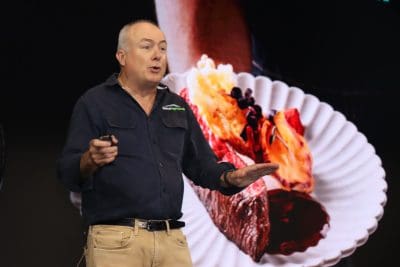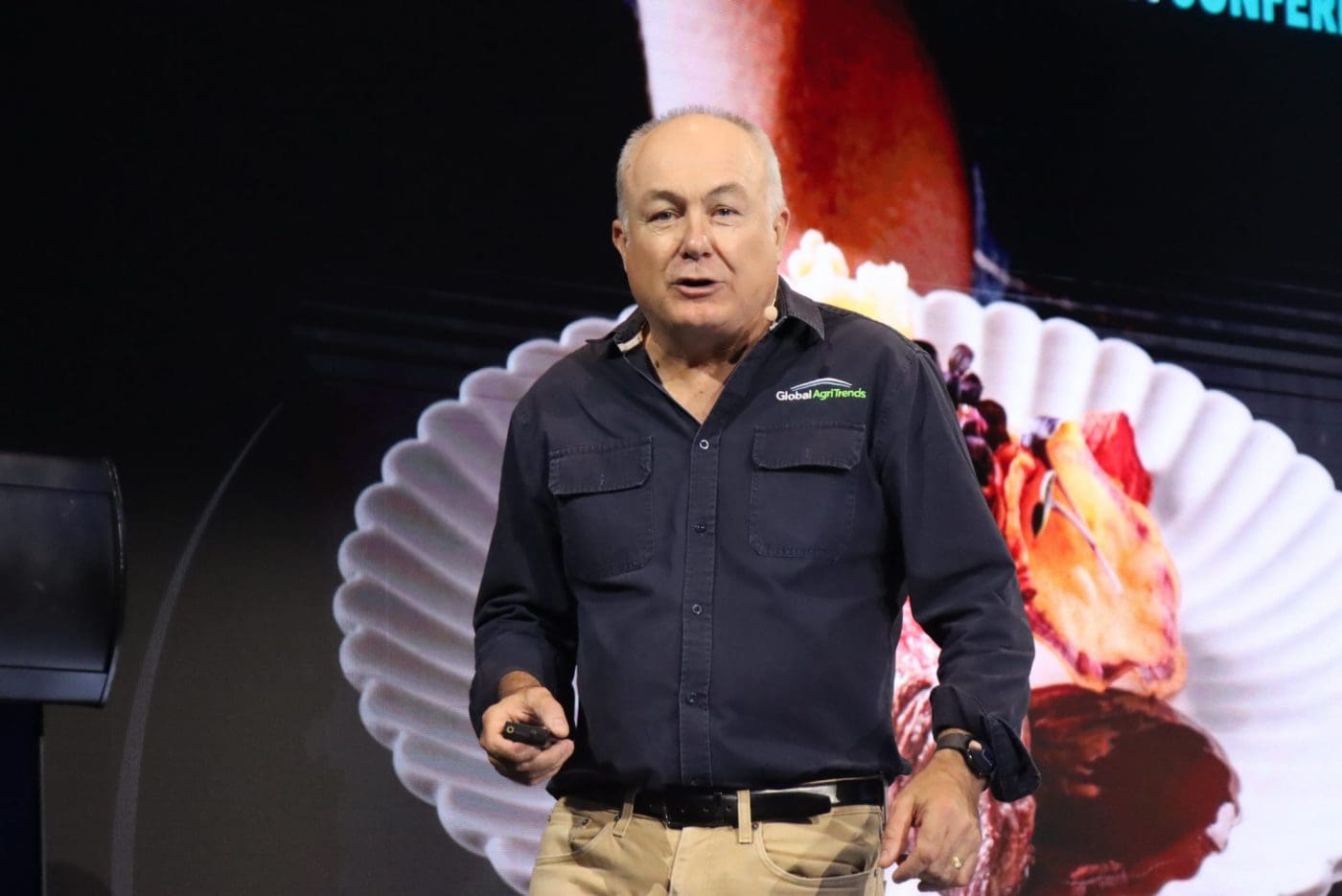Bottom line
- US herd rebuilding likely to commence this year
- Trump’s pause on tariffs helps key customers (particularly Japan and Korea) avoid recession
- Tariffs are inflationary, and Australia’s backfilling role is crucial globally
- Demand-driven cattle cycle is underway, which will see higher feeder steer prices
- Wagyu pricing will be subdued until early 2026
- Peak in Wagyu pricing is not expected until Q2 2027
ONE burning question hung in the air as analyst Simon Quilty strode onto the WagyuEdge conference stage on Thursday, 12 months after he boldly predicted at the 2024 WagyuEdge conference that Australian cattle prices were set to double by 2026.
With US President Donald Trump rewriting tariff rules and throwing global trade arrangements into almost daily turmoil in recent weeks, would he stand by or walk back his daring forecast from one year ago?
He didn’t back down.
Instead, he doubled down.
“I said last year that we would see cattle prices double in 2026,” he said as he opened his address.
“I still believe that is the case.
“And in actual fact, it will be October 2026, to really put a number and a date on time on it.”
For context, prices for several key cattle categories are indeed up on this time last year: feeder steers are 26pc above 12 months ago, heavy steers 41pc higher, cows 55pc higher, yearling heifers 36pc higher, and yearling steers 18pc higher.
There’s still some way to go before reaching Mr Quilty’s predicted 100pc increase by 2026, but, he outlined in detail why he believes a demand-driven market and tight global supply will trump Trump tariffs as the key driver of Australian cattle prices and push them higher and higher into next year.
“We’re going from a supply-driven market of the last two years, I think to a demand-driven market,” Mr Quilty said.
Tariff regime outcomes likely to be favourable for Australia
The night before his 2025 WagyuEdge conference address on Thursday, Australia woke to headlines that US President Donald Trump had decided to pause his sweeping new tariff introductions on 75 countries for 90 days, with the exception of China — where he upped the ante by increasing tariffs to 125pc.
To the extent that he see’s tariffs having an effect, Mr Quilty believes they will be largely positive for Australia.
The 90-day tariff pause has brought many countries down to a baseline 10pc tariff, which he said eased earlier concerns of a global recession and fears that it could negatively affect demand for Australian beef in key customer markets such as Japan and Korea.
Brazil has already filled its annual quota to the US — which happened in mid-January — and now incurs a higher 36.4pc tariff.
 “The clear message is that far less lean beef out of Brazil is now going into America in the last 48–72 hours, and demand for Australian beef has jumped dramatically in the last 72 hours,” Mr Quilty said.
“The clear message is that far less lean beef out of Brazil is now going into America in the last 48–72 hours, and demand for Australian beef has jumped dramatically in the last 72 hours,” Mr Quilty said.
The US decision to introduce tariffs is “very inflationary” for the US itself and will lift domestic prices.
“So as a result of that it lifts offerings into other markets around the world.”
“Australia and America share 92 percent of the Korean imported beef market. If you lift prices into Korea out of America, that creates opportunities for us, because our prices can be lifted, but also I can tell you now less US beef will go into Korea, creating more opportunities for us.”
“The same holds for Japan, they too are seeing higher offerings out of America, because it is inflationary, and as a result Australian beef into Japan is more competitive and we can put up prices and sell more volume.”
“And the same story happens all over the world, but those two markets in particular.”
US beef has been largely shut out of China, after China decided not to renew access for more than 300 US export plants. The US was shipping up to 2500 metric tonnes of beef to China per week and is now back to 50 tonnes per week.
“So right now, we are the one player in town that can really fill the void when it comes to grainfed beef into China.”
The earliest the US could regain access is June, but the increased 125pc tariff on China could mean it is much later.
“So now we have China, Korea and Japan seeking Australian beef.”
Currency movements have also improved Australia’s competitiveness
Despite lifting by 200 points following Mr Trump’s tariff pause, the Australian dollar has actually fallen in comparison with other currencies amidst the tariff chaos.
That meant Australia was in the box seat, because customers such as Korea and Japan had more spending power, and Australian beef also had greater price competitiveness compared to its export competitors.
A US expert Mr Quilty follows closely is forecasting the Australian dollar to be trading at US55c in June and at US49c by next year.
“Why? Because of China. Because of the deterioration in that market, iron ore, and our dependence on them will see that market and the Aussie fall with it.”
Herd rebuilding and global tight supply to drive prices higher
Mr Quilty said that tight supply globally would outweigh tariff effects in the years ahead.
“The lack of supply in the north and across Australia in the next few years will far outweigh any impact of tariff in my mind.”
He said that herd rebuilding was imminent.
“I think a rebuild is imminent,” he said. “We will start to see it in July this year.”
“The worst of the drought I think is over,” he added, noting the female kill ratio and price spreads between heifers and feeder steers were moving toward rebuild indicators.
US herding into herd rebuild mode
Mr Quilty said he “truly believes” the US has started their herd rebuild, with key indicators including a substantial spread between the prices for breeding heifers and slaughter heifers – now at a US $1294 (AUD$2500) premium.
“To me this is a very strong indication they’re madly moving down the path of rebuild
“The same thing happened in 2013, 2014, and 2015 when they were rebuilding last time.
“So I truly believe they have started their rebuild which means their peak in pricing will be this year.”
“Next year will be good, but this year I think will see the peak in US domestic pricing, which we will benefit from.”
(Another speaker who followed Mr Quilty, Erin Borror from the US Meat Export Federation, had a different view, suggesting an increase in US beef production is not likely until 2028 at the earliest – See Beef Central on Monday for a more detailed coverage of her address).
US domestic beef prices, he noted, were already surging.
“That to me is the true definition of a strong demand market – increased sales or volume and increased pricing.”
Australia playing a powerful “backfilling” role in global beef trade
Australia’s will play a strong backfilling role in global beef markets, he said.
“If you look at Japan for the last few years, Australia’s exports were up 15 percent, America’s fell 22pc.
“Why? Because of their rebuild and their liquidation, they are falling in numbers dramatically. Korea, we’re up 24 percent into that market. And America fell in three years in supply 22pc.
“And the same with China, we’re up 22pc, and America fell 25pc.
“We are backfilling, meaning that as America pulls away due to lack of supply, we’re filling the void.”
Cattle on feed and Wagyu outlook
Backed by these trends, it was no surprise to see record numbers of cattle on feed in Australia, he said.
“I expect that to go to 1.5 million or 1.6 million this year, as we keep backfilling around the world.
Commenting specifically on trends of relevance to Wagyu producers, Mr Quilty noted the effect that Japan’s high-end Wagyu exports is having on global markets.
“They export would you believe marble score 9+. So they are the real elite end of the market.”
Mr Quilty said Japan is currently sitting at record production levels, with slaughter up 20 pc since 2017, and most of the surplus now being exported.
“They simply do not know what do with it, so they’re going to export it,” he said.
“If you look at the overall volume, it doesn’t seem like a lot: 10,000 metric tonnes versus 2700 metric tonnes back in 2017.
“But it is up dramatically, and it floods that very high end score, 9+, all over the world, but in particular in North America”
Structural change in Wagyu market
Mr Quilty said Australia and American Wagyu producers were all aiming to upgrade marbling scores.
In America 70pc of marbling scoring for Wagyu was in the 3-4, 5-6 range, and only 30pc was in the 7-8s and 9+ range.
“Well it hasn’t quite reversed but it has got close in America. Now 55pc are in those upper marbling scores 7-8, 9 pluses. And only 45pc in those lower grades.
“And in Australia a similar story – the market is pushing higher on marbling score, where once upon a time 80pc of our marbling scoring was in the 3-6 range, today it makes up 35pc and 75pc of the people I deal with, 75pc of production is in the 6 and above range.
“We are all heading in the same direction, both in America and Australia.”
Mr Quilty said the challenge was to not be caught up in the commodity end, but also to be careful of running into Japan at the elite end of the market too.
2027 when US consumers can pay a premium again
“So the hot spot is probably the 5-6, 6-7, 7-8 marble score.”
He predicts that 2027 will be the year when inflation and wages move back together and US consumers can start to afford to pay better more for Wagyu product again.
“By the end of this year and the start of next year, my expectation is we start to get that premium back in the market, by the end of 2026 Wagyu will be back at 990 against an Angus of 775.
“2027 is where wages and inflation come back together, where the consumer can start to afford it. It is an important year.”


Given all that ‘good’ news, I’d now expect MLA to come out with a new oz cattle number of 42million and the Gov. to ban live exports because…….? and they will mouth off at China and get us banned from there also! Got to depress local beef prices so food price inflation does not hit the voters, don’t you know.